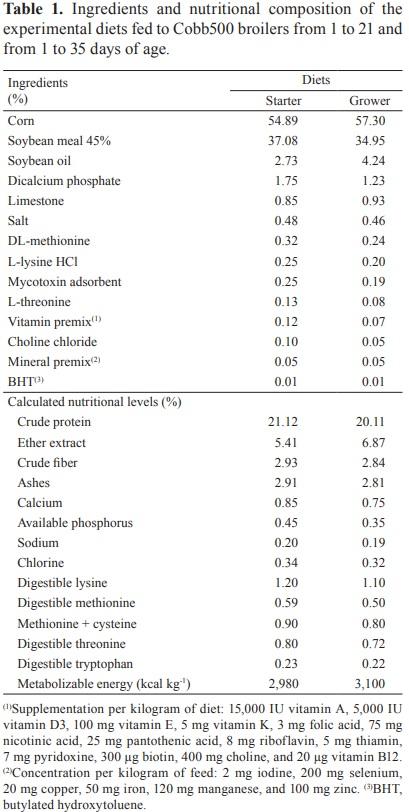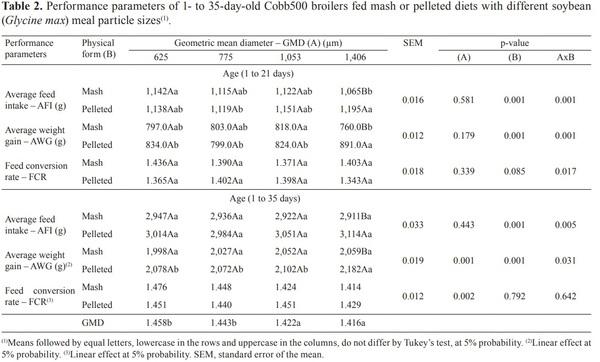Performance of broilers fed mash or pelleted diets containing different soybean meal particle sizes
The objective of this work was to evaluate the effect of different soybean meal particle sizes in pelleted or mash diets on broiler performance. A total of 1,440 male Cobb500 broilers, with 1 to 35 days of age, were evaluated. The experimental design was completely randomized, in a 2x4 factorial arrangement, consisting of two feed physical forms and four soybean meal particle sizes (625, 775, 1,053, and 1,406 μm), totaling eight treatments, with nine replicates of 20 birds each. Feed intake, weight gain, and feed conversion ratio were evaluated. There was a significant interaction between diet physical form and soybean meal particle size. From 1 to 21 days of age, the lowest feed intake and weight gain values were obtained with the mash diet containing 1,406 µm soybean meal particle size. From 1 to 35 days of age, the greatest weight gain is achieved when broilers are fed the pelleted diet with 1,406 µm soybean meal particle size.
Index terms: Glycine max, Cobb500, feed conversion ratio, feed intake.


ABDOLLAHI, M.R.; RAVINDRAN, V.; WESTER, T.J.;
RAVINDRAN, G.; THOMAS, D.V. Influence of feed form and conditioning temperature on performance, apparent metabolisable energy and ileal digestibility of starch and nitrogen in broiler starters fed wheat-based diet. Animal Feed Science and
Technology, v.168, p.88-99, 2011. DOI: https://doi.org/10.1016/j. anifeedsci.2011.03.014.
AMERAH, A.M.; GILBERT, C.; SIMMINS, P.H.; RAVINDRAN,
V. Influence of feed processing on the efficacy of exogenous enzymes in broiler diets. World’s Poultry Science Journal, v.67, p.29-46, 2011. DOI: https://doi.org/10.1017/S0043933911000031.
BEHNKE, K.C. Factors affecting pellet quality. In: MARYLAND
NUTRITION CONFERENCE, 1994, Maryland. Proceedings.
Maryland: University of Maryland, [1994]. p.44-54.
CHEWNING, C.G.; STARK, C.R.; BRAKE, J. Effects of particle size and feed form on broiler performance. Journal of Applied Poultry Research, v.21, p.830-837, 2012. DOI: https://doi.org/10.3382/japr.2012-00553.
COBB-VANTRESS. Cobb500: Broiler Performance & Nutrition
Supplement. [S.l.], 2013.14p.
DALMÉDICO, G.; ZANOTTO, D.L.; KRABBE, E.L.;
COLDEBELLA, A. Granucalc: manual do usuário. Concórdia:
Embrapa Suínos e Aves, 2013. 13p. (Embrapa Suínos e Aves.
Documentos, 159).
DUARTE, K.F.; JUNQUEIRA, O.M. Aminoácidos sintéticos e enzimas: ferramentas importantes na redução dos custos de produção de frangos de corte. Revista Produção Animal,
Avicultura, ed.73, p.22-23, 2013.
FÉLIX, A.P.; BRITO, C.B.M. de; FERRARINI, H.;
RODRIGUES, M.I.G.; OLIVEIRA, S.G. de; MAIORKA, A.
Características físico-químicas de derivados proteicos de soja em dietas extrusadas para cães. Ciência Rural, v.40, p.2568-2573,
2010. DOI: https://doi.org/10.1590/S0103-84782010001200021.
JACOBS, C.M.; UTTERBACK, P.L.; PARSONS, C.M. Effects of corn particle size on growth performance and nutrient utilization in young chicks. Poultry Science, v.89, p.539-544, 2010. DOI: https://doi.org/10.3382/ps.2009-00434.
KHERAVII, S.K.; MORGAN, N.K.; SWICK, R.A.; CHOCT, M.;
WU, S.-B. Roles of dietary fibre and ingredient particle size in broiler nutrition. World’s Poultry Science Journal, v.74, p.301-
316, 2018. DOI: https://doi.org/10.1017/S0043933918000259.
KHERAVII, S.K.; SWICK, R.A.; CHOCT, M.; WU, S.-B. Coarse particle inclusion and lignocellulose-rich fiber addition in feed benefit performance and health of broiler chickens. Poultry
Science, v.96, p.3272-3281, 2017. DOI: https://doi.org/10.3382/ps/ pex123.
KILBURN, J.; EDWARDS JR., H.M. The effect of particle size of commercial soybean meal on performance and nutrient utilization of broiler chicks. Poultry Science, v.83, p.428-432, 2004. DOI: https://doi.org/10.1093/ps/83.3.428.
LÓPEZ, C.A.A.; BAIÃO, N.C. Efeitos da moagem dos ingredientes e da forma física da ração sobre o desempenho de frangos de corte. Arquivo Brasileiro de Medicina Veterinária e Zootecnia, v.54, p.189-195, 2002. DOI: https://doi.org/10.1590/
S0102-09352002000200010.
LV, M.; YAN, L.; WANG, Z.; AN, S.; WU, M.; LV, Z. Effects of feed form and feed particle size on growth performance, carcass characteristics and digestive tract development of broilers. Animal
Nutrition, v.1, p.252-256, 2015. DOI: https://doi.org/10.1016/j. aninu.2015.06.001.
MASSUQUETTO, A.; DURAU, J.F.; BARRILLI, L.N.E.;
SANTOS, R.O.F. dos; KRABBE, E.L.; MAIORKA, A. Thermal processing of corn and physical form of broiler diets. Poultry
Science, v.99, p.3188-3195, 2020. DOI: https://doi.org/10.1016/j. psj.2020.01.027.
MASSUQUETTO, A.; PANISSON, J.C.; MARX, F.O.; SUREK,
D.; KRABBE, E.L.; MAIORKA, A. Effect of pelleting and different feeding programs on growth performance, carcass yield, and nutrient digestibility in broiler chickens. Poultry Science, v.98, p.5497-5503, 2019. DOI: https://doi.org/10.3382/ps/pez176.
MCKINNEY, L.J.; TEETER, R.G. Predicting effective caloric value of nonnutritive factors: I. Pellet quality and II. Prediction of consequential formulation dead zones. Poultry Science, v.83, p.1165-1174, 2004. DOI: https://doi.org/10.1093/ps/83.7.1065.
MORAN JR., E.T. Comparative nutrition of the fowl and swine: the gastrointestinal systems. Guelph: University of Guelph, 1982. p.185-198.
NADERINEJAD, S.; ZAEFARIAN, F.; ABDOLLAHI, M.R.;
HASSANABADI, A.; KERMANSHAHI, H.; RAVINDRAN,
V. Influence of feed form and particle size on performance, nutrient utilisation, and gastrointestinal tract development and morphometry in broiler starters fed maize-based diets. Animal
Feed Science and Technology, v.215, p.92-104, 2016. DOI: https://doi.org/10.1016/j.anifeedsci.2016.02.012.
OLIVEIRA, C.W. de; REIS, T.L.; MENDONÇA, L.V.P.;
LIMA FILHO, M. Farinhas de insetos na avicultura industrial.
Brazilian Journal of Development, v.6, p.722-728, 2020. DOI: https://doi.org/10.34117/bjdv6n1-049.
PACHECO, W.J.; STARK, C.R.; FERKET, P.R.; BRAKE,
J. Evaluation of soybean meal source and particle size on broiler performance, nutrient digestibility, and gizzard development. Poultry Science, v.92, p.2914-2922, 2013. DOI: https://doi.org/10.3382/ps.2013-03186.
ROSTAGNO, H.S. (Ed.). Tabelas Brasileiras para aves e suínos: composição de alimentos e exigências nutricionais. 3.ed. Viçosa:
Universidade Federal de Viçosa, 2011.
SANTOS, R.O.F. dos; BASSI, L.S.; SCHRAMM, V.G.;
ROCHA, C. da; DAHLKE, F.; KRABBE, E.L.; MAIORKA,
A. Effect of conditioning temperature and retention time on pellet quality, ileal digestibility, and growth performance of broiler chickens. Livestock Science, v.240, 104110, 2020. DOI: https://doi.org/10.1016/j.livsci.2020.104110.
SHABANI, S.; SEIDAVI, A.; ASADPOUR, L.; CORAZZIN, M.
Effects of physical form of diet and intensity and duration of feed restriction on the growth performance, blood variables, microbial flora, immunity, and carcass and organ characteristics of broiler chickens. Livestock Science, v.180, p.150-157, 2015. DOI: https://doi.org/10.1016/j.livsci.2015.07.006.
SIEGERT, W.; GANZER, C.; KLUTH, H.; RODEHUTSCORD,
M. Effect of particle size distribution of maize and soybean meal on the precaecal amino acid digestibility in broiler chickens. British Poultry Science, v.59, p.68-75, 2018. DOI: https://doi.org/10.1080/00071668.2017.1380295.
TEIXEIRA NETTO, M.V.; MASSUQUETTO, A.; KRABBE,
E.L.; SUREK, D.; OLIVEIRA, S.G.; MAIORKA, A. Effect of conditioning temperature on pellet quality, diet digestibility, and broiler performance. Journal of Applied Poultry Research, v.28, p.963-973, 2019. DOI: https://doi.org/10.3382/japr/pfz056.
ZAEFARIAN, F.; ABDOLLAHI, M.R.; RAVINDRAN,
V. Particle size and feed form in broiler diets: impact on gastrointestinal tract development and gut health. World’s
Poultry Science Journal, v.72, p.277-290, 2016. DOI: https://doi.org/10.1017/S0043933916000222.
ZANOTTO, D.L.; BELLAVER, C. Método de determinação da granulometria de ingredientes para uso em rações de suínos e aves. Concórdia: Embrapa-CNPSA, 1996. 5p. (Embrapa-CNPSA.
Comunicado técnico, 215).








.jpg&w=3840&q=75)